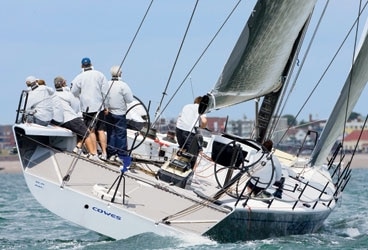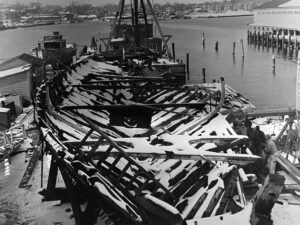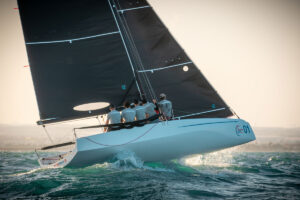
Alegre Mills 68 368
When designer Mark Mills first started talking to the owner of Alegre (who has declined to be named in this story), he quickly determined that the boat would be primarily used for IRC buoy racing on the East Coast of the United States and the Mediterranean, which made the design very different from similar-sized boats that have recently been launched.
“Part of the design process in IRC is clarifying what is required in one set of wind angles as opposed to another,” says Mills. “This owner is not making a priority of the great offshore races of the world, so we took a view that you could attempt to leverage that against the more offshore-oriented boats by producing something more inshore and medium to light-air oriented. Alegre has a narrow hull shape for lower drag, and weight in the bulb to recover some of the stability. That’s how we got to the general shape of the boat.”
Alegre is carbon-fiber, cored with Nomex, and carries a carbon-fiber Hall Spars rig held up by Future Fibre’s discontinuous composite rigging. The interior is also Nomex and carbon, and, says Mills, is slightly more comfortable than the average raceboat. “The enclosed head is nicely finished, as is the galley area, and more storage than you’d expect in a raceboat. The owner is a person who believes there’s a place for everything and everything in its place, one of his desires was that the boat wasn’t awash with various bits of gear.”
One of the most interesting features of Alegre is its lifting propeller shaft, custom made by the Dutch company Amartech from titanium. Using a joint between the driveshaft and the tail shaft that allows the whole assembly to pivot up inside the hull using a block and tackle, the entire cassette is retracted flush. “The beauty of it, other than the obvious reduction of drag that you get by not using a saildrive, is the fact that we’re using a 19-inch four-bladed prop,” says Mills. “I’d almost forgotten how good these props are in powering boats.” I see a future where someone could start making production versions of this unit, it would certainly have wider applications, because it’s night and day; Alegre powers at more than 10 knots.”
On deck there are three Harken pedestals that interlink, so any one of the three can power any of the primaries. Mills and Salter decided against linking the pedestals to a halyard winch. “We’re no longer racing boats with spinnaker poles, and therefore the weather primary in a bear-away top-mark rounding is no longer tied up with a spinnaker guy,” says Mills. “That allows us to use that primary as a powered pit winch rather than add a shaft and gearboxes to drive a halyard winch. I think that some of the new boats that were intending to fit powered winches in the pit aren’t now, although there are a few circumstances where you get into a rather complicated crossover system for jibe peels and maneuvers like that.”
At its first regatta, Ireland’s ACCBank Cork Week, Alegre finished ninth of 15 entries in the IRC Super 0 class. “There was a typical learning curve,” says Mills. “We finished the first race on Numbers’ transom, which we thought was a good position in terms of boatspeed. We’ve got a good platform to build on, and development is the key for the next couple of events.”
-Tony Bessinger
Technical Highlights
LOA 68’9″
Beam 15’4″
DSPL 30,800 lbs.
Draft 13’11”
SA (u/d) 2,800 sq. ft./6,560 sq. ft.
Sails North Sails
Mast Hall Spars
Rigging Future Fibres
Hardware Harken
Electronics B&G
Builder New England Boatworks
Project manager Guy Salter
Alegre Mills-designed IRC 68









